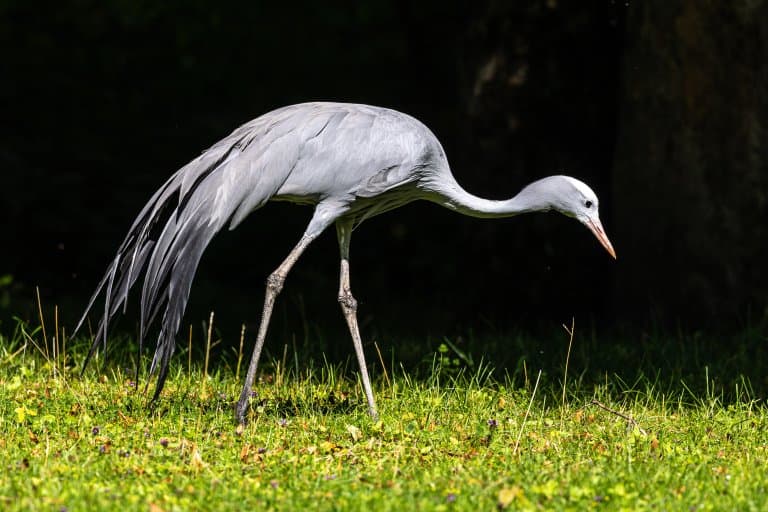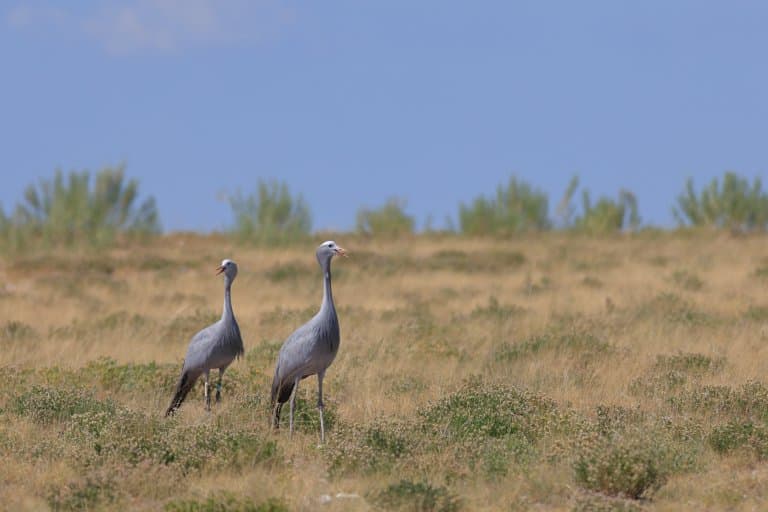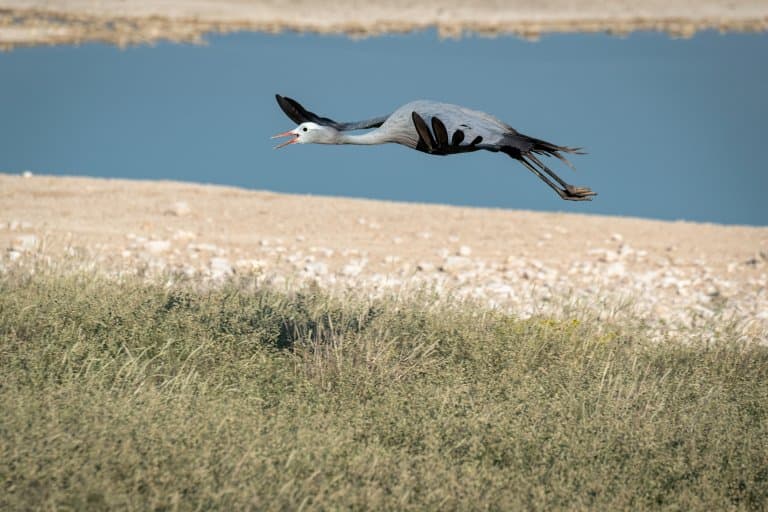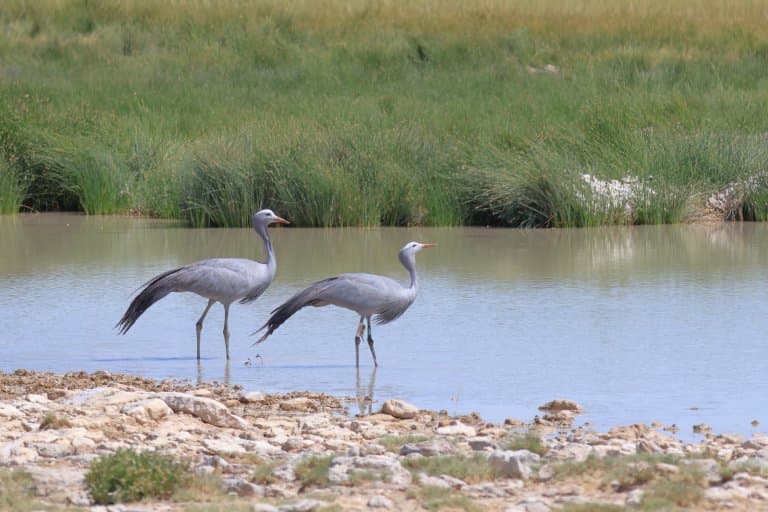Blue Crane Profile
Historically, when members of the Xhosa people (those folks with the incredible clicking language) showed bravery in battle, they were honoured with decorative feathers from the local “Indwe” bird.
The South African military pays homage to this tradition with their Nkwe ya Gauta, or “Golden Leopard” award, the ribbon for which is a characteristic blue colour in tribute to the same bird.
This is the Blue Crane, also known as the Stanley crane, or the Paradise crane – and is the National Bird of South Africa

Blue Crane Facts Overview
| Habitat: | Dry grassy uplands |
| Location: | South Africa, Namibia, and neighbouring countries |
| Lifespan: | Up to 30 years |
| Size: | 120cm (11 inches) tall, 2m (79 inch) wingspan |
| Weight: | 6.2kg (13.7 lb) |
| Colour: | Pale blue-grey, darker on upper head, neck, and nape |
| Diet: | Grasses, sedges, insects, small animalsL |
| Predators: | Large monitor lizards, snakes, foxes, jackals, raptors, mongoose |
| Top Speed: | Unknown |
| No. of Species: | 1 |
| Conservation Status: | Vulnerable (ICUN) |
The vast majority of this species lives in South Africa, with a small handful in Northern Namibia, they’re slender, with a bizarrely disproportionate head to their long, sleek necks.
These birds spend a lot of time on the ground, even for a crane, where they feed, dance and shed their incredible feathers in preparation for descending on their winter altitudinous migrations.
Sadly, despite being revered in many human cultures, this respect has proven to be mostly lip service, as the species is in decline due to rampant poisonings and climate change. Still, conservation efforts are proving to be remarkably successful, and the species stands a high chance of recovery.
Interesting Blue Crane Facts
1. They’re distinctive
There are fifteen species of crane in the family, spread out over four genera, with Grus being the most populous. While they do share some clear similarities, the blue crane, Grus paradiseus is very recognisable.
While they’re tall birds, at over one meter, this isn’t actually anything outstanding among cranes, in fact, this species is at the lower end of that spectrum. But their blue-grey plumage and funny shape set them apart.
By every written metric, these should be ugly birds. Their bobbleheads and grey plumage make them sound dull and unappealing, but the opposite is true.
Their extended wing feathers hang back like shaggy horse tails and they have a head shaped sort of like a failed balloon animal, but somehow, they manage to pull this off with a cool elegance. They’re very strange, very cute birds.
They’re also pretty good swimmers, and unlike many species, adults are often seen in the water.

2. They’re more terrestrial than usual
Despite having an impressive 2-meter wingspan, they don’t fly as much as other species and can run quite fast. This is a wetland species, with a shorter beak adapted to hunting among swampy grasses.
They appear to be quite content there, nesting in the open on the ground. They prefer areas where visibility is good and scrape bai nests into the ground with some dung for padding.
They’re commonly found in agricultural areas and will return to the same site year after year. 1
3. They dance
Cranes are well known for their awesome moves, and this one is no exception. Blue cranes have an elaborate mating dance that involves outstretched wings, high jumps and long-neck bows.
All of this motion is presumably to show off their physical prowess, and if it works, the male’s dance will be met with a synchronised response from the interested female.
This bonding ritual ideally results in a month-long shared incubation that produces chicks that can walk after just two days. Within a short period, these same youngsters are hitting the water. But this is the best-case scenario and often isn’t successful.
Blue crane chicks have a lot of enemies, and despite the fierce guarding behaviour of their parents, have a high mortality rate within the first year.
4. They Moult
Perhaps taking advantage of their terrestrial preference, this species has evolved to go through both a partial and a complete moult, involving a total overhaul of the plumage. During this time, they become flightless and gather together in large groups for added protection.
This is a nervous period for the crane, as it limits their ability to escape predators and they are justifiably and visibly nervous during flightless periods.
This moult is part of a seasonal change, during which they migrate to different altitudes. In the Summer, they migrate higher up, occupying spaces as high as 2,000m above sea level. When it gets too cold, they move back down for the Winter.
Understanding these migratory patterns and flightless periods is key to offering the species its best chance of success. 2
5. They’ve been dramatically reduced
And this is important because while this species was once common all across Southern Africa, rapid habitat change from the ‘70s has led to populations being decimated.
African farmers are notoriously anti-snake, and with some of the deadliest species in the world sitting around their crops, you can hardly blame them. Unfortunately, they don’t discriminate, and total eradication of all visible snakes is a common strategy across the continent.
And while the snake’s away, the mice will play. Rodent populations boom in the absence of predators, and these harm crops. The solution to this is widespread poisonings, and the collateral damage includes anything that eats rodents, like cranes.
Blue cranes are getting a lot of attention in this context, due in significant part to how much they mean to people in the region. 3

6. They’re symbolic
As mentioned, the Xhosa hold this species in high regard, historically using its feathers to decorate their bravest warriors. This was an honour designated directly by the chief in a ceremony called Ukundzabela. Men with these feathers worn in their hair were known for offering protection and maintaining order.
But it’s not only the Xhosa, the Zulu tribe also holds this bird in high regard. Ceremonial headdresses of kings and warriors would include the blue-grey feathers.
The blue crane is also the national bird of South Africa and is present on various icons like stamps and coins.
These symbolic gestures have proven to be insufficient in protecting the species, and while conservation efforts are proving successful, they’re still in decline.
7. They’re the only crane species known to get bone cancer
One interesting and presumably very rare cause of death is osteosarcoma or bone cancer. A single report of this occurring has shown evidence of the first such death among cranes.
This poor bird had a lump in the sternum and died before it could be treated. Autopsy showed a large mass of cancer, and remains the only such case recorded.
While this is important, it’s certainly one of the least likely causes of death; human encroachment is a substantially more urgent threat. 4
8. Power lines are a huge danger to this species
So many bird species are struggling with the rapid development of the African continent. This entire issue is an ethical minefield, as some of the most underprivileged are beginning to catch up with the developed world at significant cost to their local environments.
Power lines are a perfect example of this; Blue cranes in one study were the most commonly killed by collisions with this essential infrastructure, making up 54% of all carcasses found.
While there is no conscionable way to reduce the electrification of these countries, there are ways to do it with birds in mind. Research is ongoing to find the least destructive routes to follow when erecting power lines, as the statistics currently suggest that the fatalities in this species represent an unsustainable rate of death.
Increasing temperatures may also reduce feeding and breeding grounds, pushing this species into direct competition with livestock. Domestic dogs, inescapable water troughs and fences all represent an increased danger to chicks as a result of population development.
This is particularly present in the Namibian populations. 5

9. They have a very high conservation legacy
Fortunately for the crane, they have a very high Species Recover Score according to the IUCN’s criteria.
The Green Status of Species offers a standard for measuring the success of conservation work, and the chances of recovery for various species. Each population can be defined as Absent, Present, Viable, and Functional, with Functional being the healthiest population, contributing to ecological processes within its community, breeding well, and so on.
Blue cranes score an impressive 75% on the Species recovery score. Due to the species being spread out over four main locations, successful conservation efforts could see it becoming functional in three of these within 100 years.
Conservation efforts are key here, which gives the species a high conservation legacy, the measure of the impact of protection efforts.
Blue Crane Fact-File Summary
Scientific Classification
| Kingdom: | Animalia |
| Phylum: | Chordata |
| Class: | Aves |
| Order: | Gruiformes |
| Family: | Gruidae |
| Genus: | Grus |
| Species: | Grus Paradisea |
Fact Sources & References
- “Blue Crane – Grus paradisea”, Maisai Gallery.
- “BLUE CRANE”, Overberg Size Group.
- “Blue crane”, Britannica.
- Sarah M. Churgin (2013), “STERNAL OSTEOSARCOMA IN A BLUE CRANE (ANTHROPOIDES PARADISEUS)”, BioOne Digital Library.
- JESSICA M. SHAW (2010), “Modelling power-line collision risk for the Blue Crane Anthropoides paradiseus in South Africa”, Wiley Online Library.
